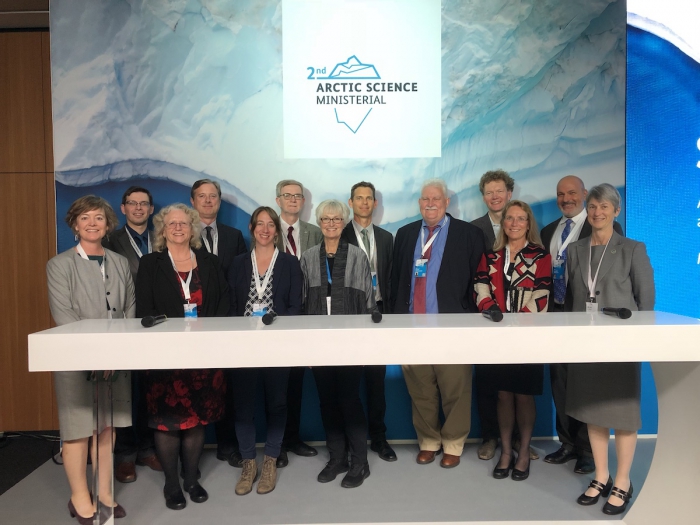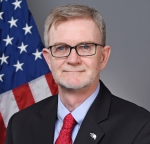By: Martin O. Jeffries, PhD, Cold Regions Research and Engineering Laboratory (CRREL), Engineer Research and Development Center, U.S. Army Corps of Engineers, Hanover, New Hampshire
On 28 September 2016 I was fortunate to spent the entire day at the first ever Arctic Science Ministerial (ASM-1), organized by the Office of Science and Technology Policy (OSTP) in the Executive Office of the President. Often referred to as the White House Arctic Science Ministerial, because it took place on the White House campus in Washington, D.C., I had high hopes for this ground-breaking meeting (See Figure 1).
High among those hopes was that it would not be the first and last Arctic Science Ministerial. That hope was almost realized very late in the day, when the head of the European Union (EU) delegation announced that the EU would consider hosting a second Arctic Science Ministerial. Consideration subsequently became confirmation, and the second Arctic Science Ministerial (ASM-2), co-organized by the EU, Finland, and Germany, was held on 25-26 October 2018 in Berlin, Germany.

I was privileged to be deeply involved in the planning and execution of ASM-1 in my capacity as Assistant Director for Polar Sciences in OSTP and Executive Director of the Interagency Arctic Research Policy Committee (IARPC), a working group of the National Science and Technology Council led by OSTP. I am doubly privileged because I was selected to be a member of the U.S. delegation to the ASM-2 Arctic Science Forum (See Figure 2).

ASM-1 was conceived when President Barack Obama visited Alaska in August 2015. It came to fruition a mere 13 months later, when the delegations of 25 governments of Arctic and non-Arctic states, plus the European Union (EU), and representatives of the Arctic Indigenous peoples' organizations (the Permanent Participants on the Arctic Council), gathered to discuss enhancement of international cooperation to deepen scientific knowledge and understanding of the Arctic. The U.S. delegation comprised Dr. John Holdren (Assistant to the President for Science and Technology, and Director of OSTP), Dr. France Córdova (Director, National Science Foundation) and the Honorable Frances 'Fran' Ulmer (Chair, U.S. Arctic Research Commission).
The White House released an ASM-1 Fact Sheet (a press release) describing the four themes of the Ministerial, some of the 150 deliverables (commitments) contributed by the participating governments in support of the themes, and a Joint Statement. Signed by all the heads of the government delegations, the Joint Statement recognizes that international collaboration and the inclusion of Arctic Indigenous peoples in science and decision-making are essential to advancing research in the Arctic, and that a new collective approach in Arctic science will inform national policies concerning climate-change mitigation and resilience, Arctic development, stewardship, and the needs of the region's Indigenous peoples.
Recognizing the particular role of Alaska Natives in science in America's Arctic, the White House invited over 40 representatives of Alaska Native communities and organizations, plus representatives of the Arctic Indigenous peoples' organizations, to a meeting on the afternoon of 27 September 2018 (See Figure 1). (Further details of this meeting are available on the 2016 OSTP blog.) It was a listening session, in which Alaska Native peoples shared, with over 40 senior U.S. Government officials, their concerns about climate change and its socio-ecological consequences, their insights into the role of Indigenous knowledge and community-based monitoring in science, and their science priorities.
Once a week for four weeks prior to ASM-1, OSTP hosted a teleconference across 13 time zones (Washington, D.C. to Tokyo) as a means to engage leaders of national and international scientific organizations in the ASM-1 process. Continued after ASM-1, those teleconferences served as a means to build collaborations, report on progress made on delivering on commitments made in September, and to transition from ASM-1 to ASM-2. That transition was completed in October 2017, when Fran Ulmer and I formally passed the gavel to the ASM-2 organizers at the Arctic Circle Assembly in Iceland.
ASM-2 was a 2-day event. Day 1 was the Arctic Science Forum (See Figure 3), where 250 scientists, Indigenous peoples and others from 26 countries, and leaders of international science organizations, gathered to review progress made since ASM-1, discuss the state of Arctic science and the three themes of ASM-2, and to continue the task of building the collaborations necessary to advance the science.

The day's proceedings were summarized by Dr. Karin Lochte (Chair of the ASM-2 Science Advisory Board and former Director of the Alfred Wegener Institute), who, a few hours later, addressed the delegates to the Ministerial itself on Day 2. Informed by the Arctic Science Forum, delegations from 26 governments of Arctic and non-Arctic states, and the European Union, plus representatives of the Arctic Indigenous peoples' organizations and international scientific organizations, proceeded to discuss further enhancing collaborative science efforts in the Arctic. The U.S. delegation comprised Dr. France Córdova, the Honorable Fran Ulmer, and Dr. Timothy Gallaudet (Assistant Secretary of Commerce for Atmosphere and Oceans, U.S. Department of Commerce).
All heads of the government delegations signed the ASM-2 Joint Statement, which states, "We strongly note the need for increased effort and urgent attention supporting further international scientific collaboration focusing on the warming trend in the Arctic. This trend is progressing fast, with widespread environmental, social, cultural, and economic impacts in the Arctic and other regions worldwide. Moreover, broader global and regional changes—both environmental and socio-economic—are challenging the region's ecosystems and the health and well-being of its communities." The Joint statement also addresses diversity and inclusion, making the case that, "cultivating talent and promoting excellence across the social spectrum will lead to better problem solving and innovative solutions to the Arctic science challenges described in this Joint Statement."
The ASM-2 Website provides a comprehensive overview of the event, including the Joint Statement, and the ASM-2 report on scientific deliverables and commitments supporting the three themes, and descriptions of the governments' Arctic research programs and activities.
There is ample evidence that the Arctic environmental system is changing, that the socio-ecological consequences of these changes are already apparent and extend far beyond the Arctic, and that international collaboration is essential to address the challenges arising from a warming Arctic. Scientists are very effective practitioners of international scientific collaboration at the person-to-person level, developing research-driven joint projects and programs from the bottom up. The Arctic Science Ministerials, where governments of Arctic and non-Arctic states are making commitments that provide high-level political and policy support for the scientists' grass-roots efforts, are an important addition to the landscape of Arctic scientific collaboration and the development of Arctic science diplomacy. The announcement at ASM-2 that Iceland and Japan will co-organize the third Arctic Science Ministerial, is, therefore, very welcome news.
About the Author
 Martin Jeffries has been with CRREL since September 2018; he has particular responsibility for strengthening the Arctic science and engineering portfolio. As a researcher at the University of Alaska Fairbanks (UAF) between 1985 and 2014, he investigated sea ice in Antarctica and the Arctic Ocean, ice shelves and ice islands (tabular icebergs) in the Canadian High Arctic, and lake ice in Alaska. From 2006 to 2014, he was detailed first to the National Science Foundation, where he was the first Program Director for the Arctic Observing Network, and then to the Office of Naval Research (ONR), where he was an Arctic Science Advisor and Program Officer for Arctic and Global Prediction, and finally to the U.S. Arctic Research Commission as a Science Advisor. Immediately upon retiring from UAF in 2014, he became a career civil servant with ONR, from where he was detailed to OSTP between February 2016 and March 2018.
Martin Jeffries has been with CRREL since September 2018; he has particular responsibility for strengthening the Arctic science and engineering portfolio. As a researcher at the University of Alaska Fairbanks (UAF) between 1985 and 2014, he investigated sea ice in Antarctica and the Arctic Ocean, ice shelves and ice islands (tabular icebergs) in the Canadian High Arctic, and lake ice in Alaska. From 2006 to 2014, he was detailed first to the National Science Foundation, where he was the first Program Director for the Arctic Observing Network, and then to the Office of Naval Research (ONR), where he was an Arctic Science Advisor and Program Officer for Arctic and Global Prediction, and finally to the U.S. Arctic Research Commission as a Science Advisor. Immediately upon retiring from UAF in 2014, he became a career civil servant with ONR, from where he was detailed to OSTP between February 2016 and March 2018.
